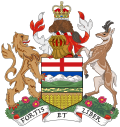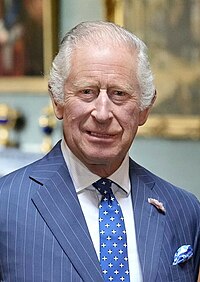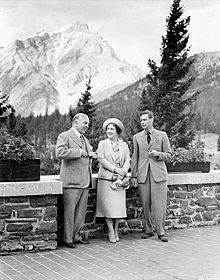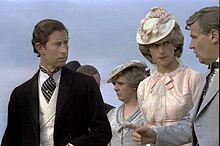Monarchy in Alberta
| King in Right of Alberta | |
|---|---|
Provincial | |
 | |
| Incumbent | |
 | |
| Charles III King of Canada since 8 September 2022 | |
| Details | |
| Style | His Majesty |
| First monarch | Edward VII |
| Formation | 1 September 1905 |
By the arrangements of the Canadian federation, Canada's monarchy operates in Alberta as the core of the province's Westminster-style parliamentary democracy.[1] As such, the Crown within Alberta's jurisdiction is referred to as the Crown in Right of Alberta,[2] His Majesty in Right of Alberta,[3] or The King in Right of Alberta.[4] The Constitution Act, 1867, however, leaves many royal duties in Alberta specifically assigned to the sovereign's viceroy, the Lieutenant Governor of Alberta,[1] whose direct participation in governance is limited by the conventional stipulations of constitutional monarchy.[5]
| Monarchy of Canada |
|---|
 |
| This article is part of a series |
Constitutional role
[edit]The role of the Crown is both legal and practical; it functions in Alberta in the same way it does in all of Canada's other provinces, being the centre of a constitutional construct in which the institutions of government acting under the sovereign's authority share the power of the whole.[6] It is thus the foundation of the executive, legislative, and judicial branches of the province's government.[7]
The Canadian monarch—since 8 September 2022, King Charles III—is represented and his duties carried out by the Lieutenant Governor of Alberta, whose direct participation in governance is limited by the conventional stipulations of constitutional monarchy, with most related powers entrusted for exercise by the elected parliamentarians, the ministers of the Crown generally drawn from amongst them, and the judges and justices of the peace.[5] The Crown today primarily functions as a guarantor of continuous and stable governance and a nonpartisan safeguard against the abuse of power.[5][8][9] This arrangement began with the granting of royal assent to the 1905 Alberta Act and continued an unbroken line of monarchical government extending back to the late 18th century.[10] However, though Alberta has a separate government headed by the King, as a province, Alberta is not itself a kingdom.[11]
The Alberta Sovereignty Within a United Canada Act gives the lieutenant governor the unique ability to, following a resolution passed by the legislature, and on ministerial advice, amend any piece of legislation ("Henry VIII powers"),[12] as well as to direct "provincial entities" to disobey any federal law for up to four years.[13] The constitutionality of these powers remains untested.
Government House in Edmonton is owned by the sovereign only in his capacity as King in Right of Alberta and is used both as an office and official event location by the lieutenant governor, the sovereign, and other members of the Canadian royal family. The viceroy resides in a separate home provided by the provincial Crown and the King and his relations reside at a hotel when in Alberta. A member of the royal family have owned Alberta property in a private capacity; King Edward VIII (later the Duke of Windsor) owned the E.P. Ranch (formerly the Bedingfield Ranch), near High River, for more than 40 years.
Royal associations
[edit]Those in the Royal Family perform ceremonial duties when on a tour of the province; the royal persons do not receive any personal income for their service, only the costs associated with the exercise of these obligations are funded by both the Canadian and Alberta Crowns in their respective councils.[14] Monuments around Alberta mark some of those visits, while others honour a royal personage or event. Further, Alberta's monarchical status is illustrated by royal names applied regions, communities, schools, and buildings, many of which may also have a specific history with a member or members of the Royal Family. Associations also exist between the Crown and many private organizations within the province; these may have been founded by a Royal Charter, received a royal prefix, and/or been honoured with the patronage of a member of the Royal Family. Examples include the Royal United Services Institute of Alberta, which is under the patronage of Prince Andrew, Duke of York, and the Royal Tyrrell Museum of Palaeontology, which received its royal prefix from Queen Elizabeth II in 1990.[15] At the various levels of education within Alberta there also exist a number of scholarships and academic awards either established by or named for members of the Royal Family.[16]
The main symbol of the monarchy is the sovereign himself, his image (in portrait or effigy) thus being used to signify government authority.[17] A royal cypher or crown may also illustrate the monarchy as the locus of authority, without referring to any specific monarch. Additionally, though the monarch does not form a part of the constitutions of Alberta's honours, they do stem from the Crown as the fount of honour, and so bear on the insignia symbols of the sovereign. The Queen or others in her family may bestow these honours in person: the Queen, when in the province in 2002, appointed Alberta citizens to the Royal Victorian Order and presented in Alberta, on her official Canadian birthday in 2005, the insignia of the Venerable Order of Saint John to new inductees.[18]
-
The Queen Alexandra School in Queen Alexandra, Edmonton, named for Queen Alexandra
History
[edit]
Prince Edward (the future King Edward VIII) first toured Alberta in 1919, when he was hosted at the Bar-U Ranch by George Lane.[19] The Prince ejoyed the province's rural life so much he purchased a 400-acre (1.6 km2) property nearby—outside Pekisko, High River—and named it E.P. Ranch (the initials a reversal of Prince Edward).[19] There, he raised cattle, sheep, and horses imported from the Duchy of Cornwall.[20] Though his father, King George V, did not approve of his son holding property in Canada—believing it would lead the other Dominions to expect the Prince to purchase land there, too[20]—Edward held this ranch and stayed at it numerous times. One such occasion was in 1923, during which time Edward participated in typical ranch chores and dining with the hired hands on basic meals.[21] Edward sold the ranch in 1962, a decade before his death.[22]
A request was made by Premier Ralph Klein for the Queen of Canada to give royal assent to a bill in the Legislative Assembly of Alberta in May 2005. This request was turned down by the Office of the Governor General "for two reasons: such an unprecedented ceremony would hinder [the office's] ability to 'Canadianize' the Crown and the constitution specifically assigns to the Lieutenant-Governor the function of giving royal assent to provincial bills."[23] That assertion, however, was contested by Professor and Senior Director of Interdisciplinary Programs at the University of Alberta, Kenneth Munro.[24]

Though Queen Elizabeth II did not tour any part of the province during her Golden Jubilee royal tour in 2002, the legislative assembly and government introduced a number of events and initiatives to mark the anniversary.[25] More than 4,000 Albertans attended the Lieutenant Governor's Jubilee Levée on 23 June, where Lois Hole stated: "what we want to realize is how important the monarchy is to Canada and certainly to Alberta."[16] Three years later, the Queen was in Alberta to mark the province's 100th anniversary of entry into Confederation, where she attended, along with an audience of 25,000, a kick-off concert at Commonwealth Stadium and addressed the legislative assembly, becoming the first reigning monarch to do so.[26] At the same time, the Ministry of Learning encouraged teachers to focus education on the monarchy and to organize field trips for their students to see the Queen and her consort, or to watch the events on television.[27]
Princess Anne, Princess Royal, visited Edmonton from 5 to 8 November 2018 to attend the 28th Royal Agricultural Society of the Commonwealth conference, which was held at Edmonton Expo Centre in conjunction with Farmfair and brought 150 attendees from 23 countries in the Commonwealth of Nations.[28] Anne, who is the society's president, took part in some of the sessions and toured the barns at Northlands. She noted that Alberta and Canada face the same challenges as other Commonwealth member-states do; namely, an aging farming population, difficulty attracting new entrants, land access, changing dietary trends, and environmental concerns.[29] At Government House, the Princess also launched the Edmonton Commonwealth Walkway, which was proposed by Lieutenant Governor Lois Hole, funded by private donors, and built "as a way to honour the long-standing service of Her Majesty the Queen and celebrate the shared values of democracy, human rights, and the rule of law that unite Commonwealth nations."[30]
In 2022, Alberta instituted a provincial Platinum Jubilee medal to mark Elizabeth II's seventy years on the Canadian throne; the first time in Canada's history that a royal occasion was commemorated on provincial medals.[31]
See also
[edit]References
[edit]- ^ a b Edward VII (20 July 1905). Alberta Act. 10. Westminster: King's Printer. Retrieved 16 June 2009.
- ^ Crown in right of Alberta v. LRB and Municipal, [1998 Alta. L.R.B.R. 332] (Court of Queen's Bench of Alberta 14 August 1998).
- ^ Elizabeth II (1 January 2002). Canadian Airlines Corporation Act. 1.a. Calgary: Alberta Queen's Printer. Retrieved 27 June 2009.
- ^ Her Majesty the Queen In Right of Alberta v. Rhonda Fjeld, 0503 02287, 2008 ABQB 558 (Court of Queen's Bench of Alberta 15 April 2008).
- ^ a b c MacLeod, Kevin S. (2008). A Crown of Maples (PDF) (1 ed.). Ottawa: Queen's Printer for Canada. p. 16. ISBN 978-0-662-46012-1. Retrieved 21 June 2009.
- ^ Cox, Noel (September 2002). "Black v Chrétien: Suing a Minister of the Crown for Abuse of Power, Misfeasance in Public Office and Negligence". Murdoch University Electronic Journal of Law. 9 (3). Perth: Murdoch University: 12. Retrieved 17 May 2009.
- ^ Privy Council Office (2008), Accountable Government: A Guide for Ministers and Ministers of State – 2008, Ottawa: Queen's Printer for Canada, p. 49, ISBN 978-1-100-11096-7, archived from the original on 18 March 2010, retrieved 17 May 2009
- ^ Roberts, Edward (2009). "Ensuring Constitutional Wisdom During Unconventional Times" (PDF). Canadian Parliamentary Review. 23 (1). Ottawa: Commonwealth Parliamentary Association: 15. Archived from the original (PDF) on 26 April 2012. Retrieved 21 May 2009.
- ^ MacLeod 2008, p. 20
- ^ Edward VII (20 July 1905), Alberta Act, Ottawa: King's Printer for Canada, retrieved 13 February 2011
- ^ Forsey, Eugene (1974). "Crown and Cabinet". In Forsey, Eugene (ed.). Freedom and Order: Collected Essays. Toronto: McClelland & Stewart Ltd. (published 31 December 1974). ISBN 978-0-7710-9773-7.
- ^ Mertz, Emily (29 November 2022), Alberta sovereignty act: Municipalities, local police could get provincial directives, Global News, retrieved 25 November 2023
- ^ Olszynski, Martin; Bankes, Nigel (6 December 2022), Running Afoul the Separation, Division, and Delegation of Powers: The Alberta Sovereignty Within a United Canada Act, University of Calgary Faculty of Law, retrieved 25 November 2023
- ^ Palmer, Sean; Aimers, John (2002), The Cost of Canada's Constitutional Monarchy: $1.10 per Canadian (2 ed.), Toronto: Monarchist League of Canada, archived from the original on 19 June 2008, retrieved 15 May 2009
- ^ "Frequently Asked Questions". Royal Tyrrell Museum Cooperating Society. Archived from the original on 16 May 2008. Retrieved 18 July 2008.
- ^ a b Hoople, Chelsea (2002). "Alberta honours its citizens in the name of the Queen". Canadian Monarchist News. Autumn 2002. Toronto: Monarchist League of Canada. Archived from the original on 8 July 2009. Retrieved 27 June 2009.
- ^ MacKinnon, Frank (1976), The Crown in Canada, Calgary: Glenbow-Alberta Institute, p. 69, ISBN 978-0-7712-1016-7
- ^ "Her Majesty Queen Elizabeth II, presents the Order of Saint John Insignia" (PDF) (Press release). Saint John Ambulance. 24 May 2005. Retrieved 27 June 2009.
- ^ a b "At Home in Canada": Royalty at Canada's Historic Places, Canad's Historic Places, retrieved 30 April 2023
- ^ a b Harris, Carolyn (3 February 2022), "Royals Who Lived in Canada", The Canadian Encyclopedia, Historica Canada, retrieved 3 April 2023
- ^ Bousfuield, Arthur; Toffoli, Garry (2010), Royal Tours 1786-2010: Home to Canada, Dundurn Press, pp. 95–98, ISBN 978-1-4597-1165-5
- ^ Department of Canadian Heritage. "Royal Visit 2001 > Getting to Know the Prince of Wales". Queen's Printer for Canada. Archived from the original on 6 May 2008. Retrieved 9 May 2007.
- ^ Munro, Kenneth (June 2006). "Can the Queen Grant Royal Assent in a Provincial Legislature?: Yes" (PDF). Canadian Monarchist News. Fall-Winter 2005 (24). Toronto: Monarchist League of Canada: 17. Retrieved 26 February 2012.
- ^ Toporoski, Richard; Munro, Kenneth (June 2006). "Can the Queen Grant Royal Assent in a Provincial Legislature?" (PDF). Canadian Monarchist News. Fall-Winter 2005 (24). Toronto: Monarchist League of Canada: 17–20. Retrieved 26 February 2012.
- ^ Elizabeth II (20 March 2002), Queen Elizabeth II Golden Jubilee Recognition Act, 2, Edmonton: Queen's Printer for Alberta, retrieved 8 August 2010
- ^ Government of Alberta. "Alberta Centennial Home > Official Events > Celebrate Alberta Kick-Off Party". Alberta Queen's Printer. Archived from the original on 26 July 2009. Retrieved 28 June 2009.
- ^ Government of Alberta. "Education Home > Centennial Projects > Alberta students encouraged to join the festivities the Royal Visit 2005". Alberta Queen's Printer. Retrieved 28 June 2009.
- ^ Bloom, David (6 November 2018), "Princess Anne opens 28th Commonwealth Agriculture Conference in Edmonton", Edmonton Journal, retrieved 7 November 2023
- ^ Kienlen, Alexis (21 November 2018), Royalty comes to Edmonton’s Farmfair International, Alberta Farmer, retrieved 7 November 2023
- ^ Wakefield, Jonny (6 November 2018), "Princess Anne's first Edmonton visit features cows, curtsies", Edmonton Journal, retrieved 7 November 2023
- ^ "Queen's Platinum Jubilee medal". Government of Alberta. Retrieved 11 August 2022.
Sources
[edit]- MacLeod, Kevin S. (2008). A Crown of Maples (PDF) (1 ed.). Ottawa: Queen's Printer for Canada. p. 16. ISBN 978-0-662-46012-1. Retrieved 21 June 2009.
External links
[edit]- Ministry of Education (2005). "The Monarchy in Alberta: Teacher and Student Resource" (PDF). Queen's Printer for Alberta.
- Office of the Premier. "Premier > Royal Visit". Queen's Printer for Alberta.
- Provincial Archives of Alberta. "Culture and Community Spirit > Heritage and Museums > Provincial Archives of Alberta > Reference Services > Royal Visits - Textual Records". Queen's Printer for Alberta.
- Provincial Archives of Alberta. "Culture and Community Spirit > Heritage and Museums > Provincial Archives of Alberta > Reference Services > Royal Visits photos". Queen's Printer for Alberta.
- Provincial Archives of Alberta. "Culture and Community Spirit > Heritage and Museums > Provincial Archives of Alberta > Reference Services > Royal Visits - Film and Video Sources". Queen's Printer for Alberta.
- Queen becomes longest reigning British monarch at lieutenantgovernor.ab.ca





